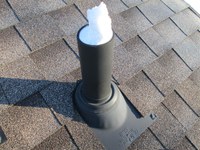Now is Time to Protect Sewer Vents From Freezing
(Click the image below to view a high-resolution image that can be downloaded)
Last winter was long and cold. That was the perfect weather to cause frozen sewer vent pipes on many houses.
“Now, while the weather is nice and there is no snow on the roof, is the time to insulate or extend sewer vent pipes so they do not get covered with snow or freeze shut this winter,” North Dakota State University Extension Service agricultural engineer Tom Scherer says.
Sewer vent pipes are on the roof of homes and other buildings. The diameter of the vent pipe varies from 1 1/2 to 6 inches. Typically, the short, smaller diameter vent pipes (less than 4 inches) can freeze shut. Sewer vent pipes on the north side of the roof also may be more prone to frost plugging than those on the south side of the roof.
House plumbing systems include sewer pipes, vent pipes and water traps. A house may have one or many sewer vent pipes. All are important and necessary for a properly functioning house sewer system.
Sewer pipes have to be vented to allow air into the pipe for proper flow. The sewer pipe and vent pipes are connected so wastewater flows downward and sewer gases rise. During extended periods of very cold weather, sewer gas containing water vapor will condense, then freeze to form a frost layer in the exposed uninsulated end of the vent pipe. This frost layer can seal the pipe partially or fully, forming a plug. Hard, drifted snow also can plug the end of the vent pipes.
If the end of the vent pipe is plugged, proper draining will be hampered and air will be pulled into the piping, which will drain the traps of water fixtures. This allows sewer gas into the house. The gas, primarily composed of methane and carbon monoxide, will have an obvious “sewer” smell; however, some harmful gases are odorless.
“The first indication of trouble may be the toilet gurgling or not flushing properly as water is pulled from the traps to replace existing water and air flow,” Scherer says. “Sewer gas may cause people to become sick with symptoms such as headache, nausea and/or dizziness.”
Frozen sewer vents have been a problem in many newer homes because the plastic pipes in those homes do not conduct heat from inside the house as well as the cast iron vent pipes in older homes. Also, attics in newer homes are very well insulated and do not have heat in this area, so the vent pipe is colder farther into the house. In addition, many newer homes have two, three or even four bathrooms, plus dishwashers and whirlpool baths, all of which increase the water vapor in the sewer system.
Many products are on the market to help solve this problem. A common method is to attach an insulated sleeve over the outside end of the vent pipe. These sleeves not only insulate the vent pipe but also extend it higher into the air. The intent is to keep the water vapor and gases above the freezing point until they exit the end of the vent pipe. Many hardware and home supply stores carry pre-made insulated units that you can attach to the vent pipe easily.
“Even though the weather is nice and there is no snow on the roof to contend with, be careful.” Scherer cautions. “If you don’t feel safe climbing onto the roof, find someone who will, and use proper ladders and other protection.”
Attaching the insulated sleeve to the sewer vent pipe is not difficult, and some are made to slip on without tools. However, for these to work properly, you must know the diameter of the vent before you purchase the insulating sleeve. This will require getting on the roof to measure the vents first.
Even sewer vent pipes with insulated sleeves have been known to freeze shut, which may be due to exposed bare pipe in the attic, according to Scherer. If you can get access to the attic from inside the house, wrap a batting of fiberglass insulation around the vent pipe in the attic. Another option is to wrap heat tape around the exposed sewer vent pipe in the attic and then insulate over the tape.
Heat tape is a long cord with a heating element and a thermostat to sense when the pipe is exposed to freezing temperatures. The thermostat on the tape should not be insulated because it is meant to measure the ambient air temperature of the space where the tape is being used. Leave it plugged in all winter, but check that it is working before each fall.
“Remember, an ounce of prevention now will help prevent sewer vent problems this winter,” Scherer says.
NDSU Agriculture Communication - Oct. 24, 2014
| Source: | Tom Scherer, (701) 231-7239, thomas.scherer@ndsu.edu |
|---|---|
| Editor: | Ellen Crawford, (701) 231-5391, ellen.crawford@ndsu.edu |


